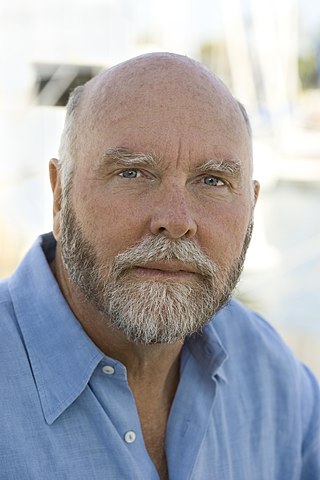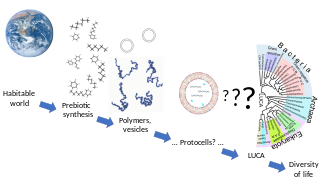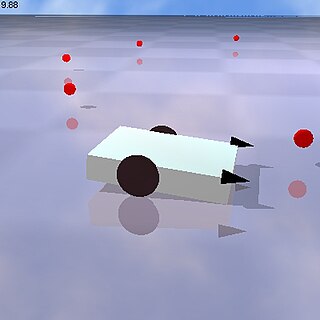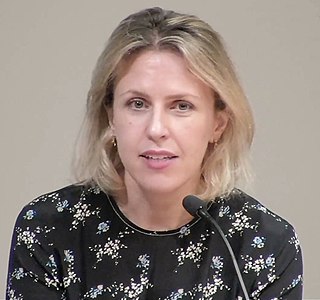Related Research Articles

John Craig Venter is an American biotechnologist and businessman. He is known for leading one of the first draft sequences of the human genome and assembled the first team to transfect a cell with a synthetic chromosome. Venter founded Celera Genomics, the Institute for Genomic Research (TIGR) and the J. Craig Venter Institute (JCVI). He was the co-founder of Human Longevity Inc. and Synthetic Genomics. He was listed on Time magazine's 2007 and 2008 Time 100 list of the most influential people in the world. In 2010, the British magazine New Statesman listed Craig Venter at 14th in the list of "The World's 50 Most Influential Figures 2010". In 2012, Venter was honored with Dan David Prize for his contribution to genome research. He was elected to the American Philosophical Society in 2013. He is a member of the USA Science and Engineering Festival's advisory board.
The iron–sulfur world hypothesis is a set of proposals for the origin of life and the early evolution of life advanced in a series of articles between 1988 and 1992 by Günter Wächtershäuser, a Munich patent lawyer with a degree in chemistry, who had been encouraged and supported by philosopher Karl R. Popper to publish his ideas. The hypothesis proposes that early life may have formed on the surface of iron sulfide minerals, hence the name. It was developed by retrodiction from extant biochemistry in conjunction with chemical experiments.

Alexander Ivanovich Oparin was a Soviet biochemist notable for his theories about the origin of life, and for his book The Origin of Life.

Synthetic biology (SynBio) is a multidisciplinary field of science that focuses on living systems and organisms, and it applies engineering principles to develop new biological parts, devices, and systems or to redesign existing systems found in nature.

Coacervate is an aqueous phase rich in macromolecules such as synthetic polymers, proteins or nucleic acids. It forms through liquid-liquid phase separation (LLPS), leading to a dense phase in thermodynamic equilibrium with a dilute phase. The dispersed droplets of dense phase are also called coacervates, micro-coacervates or coacervate droplets. These structures draw a lot of interest because they form spontaneously from aqueous mixtures and provide stable compartmentalization without the need of a membrane.
Artificial creation is a field of research that studies the primary synthesis of complex lifelike structures from primordial lifeless origins.
An artificial cell, synthetic cell or minimal cell is an engineered particle that mimics one or many functions of a biological cell. Often, artificial cells are biological or polymeric membranes which enclose biologically active materials. As such, liposomes, polymersomes, nanoparticles, microcapsules and a number of other particles can qualify as artificial cells.

Biological organisation is the organisation of complex biological structures and systems that define life using a reductionistic approach. The traditional hierarchy, as detailed below, extends from atoms to biospheres. The higher levels of this scheme are often referred to as an ecological organisation concept, or as the field, hierarchical ecology.
A protocell is a self-organized, endogenously ordered, spherical collection of lipids proposed as a stepping stone toward the origin of life. A central question in evolution is how simple protocells first arose and how they could differ in reproductive output, thus enabling the accumulation of novel biological emergences over time, i.e. biological evolution. Although a functional protocell has not yet been achieved in a laboratory setting, the goal to understand the process appears well within reach.

In biology, abiogenesis or the origin of life is the natural process by which life has arisen from non-living matter, such as simple organic compounds. The prevailing scientific hypothesis is that the transition from non-living to living entities on Earth was not a single event, but a process of increasing complexity involving the formation of a habitable planet, the prebiotic synthesis of organic molecules, molecular self-replication, self-assembly, autocatalysis, and the emergence of cell membranes. Many proposals have been made for different stages of the process.

Targeted drug delivery is one of many ways researchers seek to improve drug delivery systems' overall efficacy, safety, and delivery. Within this medical field is a special reversal form of drug delivery called chemotactic drug targeting. By using chemical agents to help guide a drug carrier to a specific location within the body, this innovative approach seeks to improve precision and control during the drug delivery process, decrease the risk of toxicity, and potentially lower the required medical dosage needed. The general components of the conjugates are designed as follows: (i) carrier – regularly possessing promoter effect also on internalization into the cell; (ii) chemotactically active ligands acting on the target cells; (iii) drug to be delivered in a selective way and (iv) spacer sequence which joins drug molecule to the carrier and due to it enzyme labile moiety makes possible the intracellular compartment specific release of the drug. Careful selection of chemotactic component of the ligand not only the chemoattractant character could be expended, however, chemorepellent ligands are also valuable as they are useful to keep away cell populations degrading the conjugate containing the drug. In a larger sense, chemotactic drug-targeting has the potential to improve cancer, inflammation, and arthritis treatment by taking advantage of the difference in environment between the target site and its surroundings. Therefore, this Wikipedia article aims to provide a brief overview of chemotactic drug targeting, the principles behind the approach, possible limitations and advantages, and its application to cancer and inflammation.

Artificial life is a field of study wherein researchers examine systems related to natural life, its processes, and its evolution, through the use of simulations with computer models, robotics, and biochemistry. The discipline was named by Christopher Langton, an American theoretical biologist, in 1986. In 1987 Langton organized the first conference on the field, in Los Alamos, New Mexico. There are three main kinds of alife, named for their approaches: soft, from software; hard, from hardware; and wet, from biochemistry. Artificial life researchers study traditional biology by trying to recreate aspects of biological phenomena.
Michael Simon Toon is an English photographer, filmmaker, designer and builder.
Jeewanu are synthetic chemical particles that possess cell-like structure and seem to have some functional properties; that is, they are a model of primitive cells, or protocells. It was first synthesised by Krishna Bahadur, an Indian chemist and his team in 1963. Using photochemical reaction, they produced coacervates, microscopic cell-like spheres from a mixture of simple organic and inorganic compounds. Bahadur named these particles 'Jeewanu' because they exhibit some of the basic properties of a cell, such as the presence of semipermeable membrane, amino acids, phospholipids and carbohydrates. Further, like living cells, they had several catalytic activities. Jeewanu are cited as models of protocells for the origin of life, and as artificial cells.

In biochemistry, biomolecular condensates are a class of membrane-less organelles and organelle subdomains, which carry out specialized functions within the cell. Unlike many organelles, biomolecular condensate composition is not controlled by a bounding membrane. Instead, condensates can form and maintain organization through a range of different processes, the most well-known of which is phase separation of proteins, RNA and other biopolymers into either colloidal emulsions, gels, liquid crystals, solid crystals or aggregates within cells.
Katarzyna (Kate) P Adamala is an American synthetic biologist and a professor of genetics at the University of Minnesota.
Living technology is the field of technology that derives its functionality and usefulness from the properties that make natural organisms alive. It may be seen as a technological subfield of both artificial life and complex systems and is relevant beyond biotechnology to nanotechnology, information technology, artificial intelligence, environmental technology and socioeconomic technology for managing human society.

Alexandra Daisy Ginsberg is a British and South African artist who lives and works in London, UK. She is known for artworks that explore the relationship between humans, technology and nature.
The history of research into the origin of life encompasses theories about how life began, from ancient times with the philosophy of Aristotle through to the Miller-Urey experiment in 1952.
A scenario is a set of related concepts pertinent to the origin of life (abiogenesis), such as the iron-sulfur world. Many alternative abiogenesis scenarios have been proposed by scientists in a variety of fields from the 1950s onwards in an attempt to explain how the complex mechanisms of life could have come into existence. These include hypothesized ancient environments that might have been favourable for the origin of life, and possible biochemical mechanisms.
References
- ↑ Toon, Michael Simon (2011). "Protocell Circus". YouTube.
- ↑ "Rachel Armstrong: Applied scientist, innovator." Speakers, Ted.com. (c) TED Conferencing LLC. Accessed 7-31-13.
- 1 2 "Living Chemistry & A "Natural History" of Protocells." Archived 2016-03-09 at the Wayback Machine Synth-ethic: Art and Synthetic Biology Exhibition 2013. 14.05 – 26.06.2011 in the Natural History Museum, Vienna, Austria. Produced by Biofaction KG. Added 20-4-2011 21:09.
- ↑ "Protocell Circus". YouTube. 2011-01-08. Retrieved 2019-09-01.
- ↑ Armstrong, Rachel. (2012) "A Trip To The Living City Of The Future." Fast Company.
- ↑ Armstrong, Rachel; Hanczyc, Martin (2013). "Bütschli Dynamic Droplet System". Artificial Life. 19 (3_4): 331–346. doi:10.1162/ARTL_a_00111. PMID 23834593.
- ↑ Wagget, Rebeccah. "Understanding Abiogenesis moving from polymers to protocells." Worksheet. Department of Biology. University of Tampa. Accessed 8-4-13.
- ↑ "Martin Hanczyc:The Thin Line Between Life And Not Life". TED Talk. Filmed May 2011. Posted Nov 2011.
- ↑ Marchant, Jo (2011). "Oil droplets mimic early life". Nature. doi:10.1038/news.2011.118.
- ↑ Toon, Michael Simon. "Protocell Video". proto-futures: all things related protocell technology. Updated 10-27-2012.
- ↑ Schmidt, Marcus (2011). "Production of synthetic biology in science, media, film and art". Life Workshop. Presentations of the meeting of the German Ethics Council. Berlin. (C) 2013 German Ethics Council. p. 36.
- ↑ Toon, Michael Simon (January 8, 2011) Werkstatt Leben. Bedeutung der Synthetischen Biologie für Wissenschaft und Gesellschaft. RUclip.com.
- ↑ "Future Sex Panel Discussion." Future Human season. British Film Institute. BFI Southbank, London, UK.
- ↑ "Digital Art@Google: We Write This To You From The Distant Future." TheProjectRoom.org. August 20 – October 22, 2010.